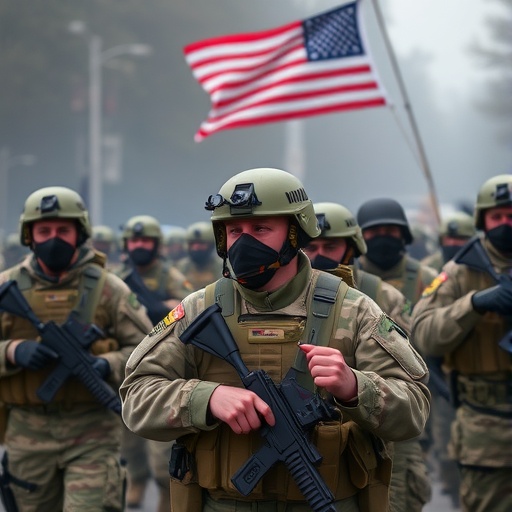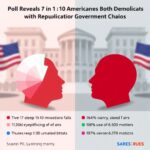Federal Appeals Court Clears Path for Trump‘s National Guard Deployment in Oregon Amid Portland Unrest
In a stunning reversal that has sent shockwaves through the Pacific Northwest, a federal appeals court on Tuesday ruled in favor of President Donald Trump‘s authority to deploy National Guard troops to Oregon, overturning a lower court’s block on the move. The decision, stemming from escalating protests in Portland, intensifies a bitter standoff between federal forces and local activists, raising fears of further clashes in the city that has become a flashpoint for nationwide unrest.
- Court’s Swift Reversal Ignites Debate on Federal Overreach
- Portland’s Protest Epicenter: From Peaceful Marches to Federal Standoff
- Trump’s Law-and-Order Push: Rhetoric Meets Reality in Oregon
- Local Outcry Grows: Oregon Leaders Vow to Fight Federal Intrusion
- Escalation Looms: National Guard Arrival and Broader National Ramifications
The ruling by the 9th U.S. Circuit Court of Appeals comes at a critical juncture, just weeks before the 2020 presidential election. Portland, long a hub for Black Lives Matter demonstrations, has seen nightly protests since the killing of George Floyd in May, with tensions boiling over into confrontations with law enforcement. Trump‘s administration argued that the deployments were necessary to protect federal property and restore order, a position now bolstered by the court’s 2-1 decision.
Court’s Swift Reversal Ignites Debate on Federal Overreach
The federal appeals court’s ruling marks a pivotal shift in the legal battle over Trump’s National Guard deployment in Oregon. Issued late Monday evening, the decision vacated a September injunction from U.S. District Judge Michael Simon, who had deemed the federal intervention an overreach into state affairs. The appeals panel, led by Judge Milan D. Smith Jr., contended that the lower court erred in interpreting the Posse Comitatus Act, which limits military involvement in domestic law enforcement.
“The president’s authority under the Insurrection Act and related statutes provides a clear basis for deployment in situations threatening federal interests,” the majority opinion stated, emphasizing incidents of vandalism at the Mark O. Hatfield Federal Courthouse in Portland. The court highlighted over 100 nights of protests, during which federal buildings were targeted with lasers, fireworks, and graffiti, resulting in more than 1,000 arrests since July.
Legal experts were quick to dissect the implications. “This court ruling doesn’t just greenlight the National Guard; it signals a broader acceptance of federal muscle in urban hotspots,” said Rachel Barkow, a professor at New York University School of Law. She noted that the decision could set a precedent for similar actions in other protest-torn cities like Seattle and Kenosha, Wisconsin.
Critics, however, decried the ruling as a dangerous precedent. Oregon Attorney General Ellen Rosenblum, who led the state’s challenge, called it “a dark day for federalism.” In a statement, she vowed to appeal to the U.S. Supreme Court, arguing that the deployment violates the 10th Amendment by infringing on state sovereignty.
Portland’s Protest Epicenter: From Peaceful Marches to Federal Standoff
Portland’s streets have been a battleground since late May, when demonstrations against police brutality drew tens of thousands. What began as peaceful vigils evolved into chaotic nightly clashes, with protesters hurling projectiles at officers and federal agents responding with tear gas and rubber bullets. The city’s unrest has drawn national attention, symbolizing the deep divisions over race, policing, and presidential power.
Statistics paint a grim picture: According to the Portland Police Bureau, over 6,000 arrests have been made in Oregon since the protests started, with property damage estimated at $23 million. Federal officials report that unmarked vans—dubbed “kettling” operations—have detained more than 100 individuals, sparking lawsuits over civil rights violations.
Trump’s initial response in July involved deploying U.S. Marshals and Border Patrol agents to guard federal sites, a move that local leaders labeled an “occupation.” Oregon Governor Kate Brown, a Democrat, negotiated a partial withdrawal of federal agents in late July, but tensions reignited in September when renewed violence prompted Trump to seek National Guard assistance. The Guard, comprising about 1,000 troops from Oregon’s own ranks, would augment federal efforts under the court’s approval.
Local voices echo the frustration. “Portland has been protesting for justice, not inviting an army,” said Terrell Johnson, a community organizer with the Portland Committee on Community-Engaged Policing. In interviews with residents, many expressed fear that National Guard presence could escalate violence rather than quell it, drawing parallels to the 1968 Democratic National Convention in Chicago.
- Key Protest Milestones: May 29 – First major march draws 10,000; June 15 – Federal agents arrive; July 4 – Courthouse firebombing attempt; September 20 – Lower court blocks Guard deployment.
- Demographic Impact: 70% of arrestees are Oregon residents under 30, per state data.
Trump’s Law-and-Order Push: Rhetoric Meets Reality in Oregon
President Trump’s advocacy for the National Guard deployment in Oregon fits into his broader “law and order” campaign narrative, positioning him as a bulwark against chaos in Democratic-led states. In a White House briefing, Press Secretary Kayleigh McEnany defended the move, stating, “Portland’s unrest isn’t protest—it’s anarchy. The court ruling affirms President Trump’s duty to protect federal assets and American citizens.”
Trump himself took to Twitter, posting: “Great decision by the Appeals Court! Time to bring peace to Portland and stop the radical left’s destruction. #MAGA.” The post, viewed over 5 million times, amplified the political stakes, with supporters praising it as decisive leadership and opponents decrying it as authoritarian overreach.
Behind the scenes, the administration cited specific threats: In August alone, federal agents documented 50 assaults on officers in Portland, including the use of commercial-grade fireworks as improvised explosives. The National Guard’s role, as outlined in deployment plans, would include perimeter security and logistical support, not direct policing—a distinction the court deemed permissible.
Polls reflect the polarized views. A recent Reuters/Ipsos survey found 52% of Americans support federal intervention in Portland, up from 45% in July, but approval drops to 28% among Democrats. In Oregon, a governor’s office poll showed 65% of residents opposing the Guard’s involvement, underscoring the state’s progressive leanings.
Experts like Heather Hurlburt from the Center for International Policy warn that Trump’s strategy could backfire electorally. “Deploying the National Guard in Oregon plays into narratives of federal aggression, potentially alienating swing voters in the West,” she said.
Local Outcry Grows: Oregon Leaders Vow to Fight Federal Intrusion
The court ruling has galvanized opposition in Oregon, where state and city officials are mobilizing resources to resist the National Guard deployment. Portland Mayor Ted Wheeler, who has navigated a delicate balance between supporting protesters and maintaining order, issued a fiery rebuke: “This isn’t about law and order; it’s about power. We won’t let Washington dictate Portland’s future.”
Governor Brown echoed these sentiments, announcing plans to redirect state resources toward de-escalation training for local police. “Oregon’s National Guard serves our communities, not federal agendas,” she said in a press conference, flanked by faith leaders and civil rights advocates. The state has already filed an emergency motion for a stay, aiming to halt implementation pending Supreme Court review.
Community groups are also stepping up. The Don’t Shoot Portland coalition, representing over 50 organizations, plans a massive rally this weekend, expecting 20,000 participants. “The court’s decision ignores the root causes—systemic racism and police violence,” said coalition co-chair Usama Kahf. Quotes from affected families, like that of a protester injured by federal munitions, add a human element to the resistance.
Economically, the unrest has cost Portland dearly. Tourism revenue plummeted 40% in Q3 2020, per city estimates, with small businesses boarding up windows nightly. Hotel occupancy rates hover at 35%, down from 75% pre-pandemic, as visitors steer clear of the volatility.
- State Responses: Enhanced mutual aid pacts with neighboring states; Legal challenges via ACLU partnerships.
- Civil Liberties Concerns: Reports of 15 unlawful detentions by federal agents, per Human Rights Watch.
Escalation Looms: National Guard Arrival and Broader National Ramifications
As National Guard units prepare to mobilize in Oregon, the stage is set for potential flashpoints that could ripple across the U.S. Deployment logistics call for 500 troops arriving by week’s end, stationed at federal facilities in Portland and Salem. Training emphasizes non-lethal crowd control, but skeptics question whether that will hold amid heated rhetoric.
Looking ahead, the Supreme Court’s involvement could redefine presidential powers. If the high court upholds the appeals decision, it might embolden similar federal actions in other states, from California to New York. Conversely, a reversal could clip Trump’s wings in his final campaign push, framing the election as a referendum on governance styles.
Security analysts predict a 30% uptick in protest activity post-ruling, based on patterns from July’s federal incursion. International observers, including UN human rights rapporteurs, have urged restraint, citing risks to free assembly rights. For Portland residents, the uncertainty weighs heavy—will the Guard bring calm or catalyze more division?
In the words of a veteran protester, Maria Gonzalez: “We’ve fought for 100 nights; we won’t stop now.” As Oregon braces for this new chapter, the nation’s eyes remain fixed on Portland, where the intersection of law, protest, and politics continues to unfold with unpredictable intensity.









